Equal to any in the world: the surveyors of NSW 1862-1884
After 40 years as a professional historian, Dr Terry Kass embarked on a labour of love and has produced a volume that will be cited for years to come. This detailed reference book is invaluable for anyone interested in the history of land settlement and the mechanism of surveying in NSW, especially during the peak period when land was being ‘opened up’ for white settlement. This project complements Kass’s earlier work relating to land records and surveying, in particular his 2008 volume, Sails to Satellites, the Surveyors General of NSW (1786-2007).
READ REVIEW
↓
Equal to any in the world:
the surveyors of NSW 1862-1884
terry kass | 2023
This new volume begins with an overview of the early British – predominantly military – origins of surveying in NSW until 1855, when training became formalised and the profession was gradually ‘taken over by colonials’. As a result, in the 1860s and 1870s most surveyors were not only Australian-trained, but also Australian-born.
Kass details the practicalities of surveying, the equipment needed, the (often acrimonious) dealings with head office, and the careers of individuals. As well as high-profile, successful surveyors such as Edward Twynam, others who served in NSW were deemed failures, never to be employed again. This was at times a well-paid profession, especially at the peak of the Sydney suburban boom in 1885 when many surveyors went into lucrative private practice. Occasionally, however, the work was so enervating that premature death resulted. Indeed, when Sir Thomas Mitchell commented on how some surveyors ‘died miserably’, he was thinking of two of his own sons. The tragic story of surveyor Henry Mylne, who took his own life on Manly Beach in December 1883, demonstrates just one incidence of poor mental health in the profession.
Surveyors had to work through droughts and floods. It was not an easy job, for example, doing a survey between Port Macquarie and Walcha, which in 1882 was ‘almost totally covered with high tree ferns, gigantic Stringybarks and Blackbutts, and fallen timber also of an immense size’. While such terrain was difficult, many surveyors appreciated the beauty of the Australian landscape, as demonstrated by the delightful surveyors’ sketches on pages 215 and 217. This unexpected side to the profession is highlighted in the chapter, ‘Environmental Sensibility’, which focuses on aspects of the surveyors’ work that was not purely utilitarian. Kass comments that Patrick Donaldson’s map of the Parish of Harwood on the Clarence River might have seemed to be a ‘geometrical cadastre’, but the survey plan reveals a ‘complex ecology’. Then there is the example of Robert Fitzgerald, whose ‘personal response to the beauty of the orchid’, Kass suggests, ‘could almost be described as environmental eroticism’.
Kass’s style is usually neutral – even bland at times – but restrained emotion is evident when he disputes the argument that surveyors were harbingers of empire, taking possession of the land from Indigenous owners. While essentially portraying them as functionaries ‘just following orders’, he concludes that surveyors had an ‘ambiguous role in dispossession’. In my view, this discussion, tucked away in chapter 3, should have been given more prominence.
Illustrations are copious, with portraits of a range of surveyors, including a gaol photo of surveyor John Roche Ardill while he was awaiting trial for criminal libel. There are photos of survey camps and a particularly fine image of a surveying party in the 1890s, also featured on the front cover. However, I question the wisdom of including large-scale maps and plans, such as an 1881 map of NSW showing surveyors’ districts, which even as a full-page reproduction is too small to make out the details.
Equal to any in the World includes a comprehensive index, 10 pages of bibliography, footnotes rather than endnotes, and seven appendices. These list land surveyed, surveyors (licensed or employed), surveyors licensed, ‘superior survey staff’ and detailed records left by individual surveyors. Kass includes fathers’ – usually middle-class – occupations to suggest the class origins of the surveyors and to highlight the incidence of sons following their fathers into the profession.
This work, the culmination of a long career investigating NSW land records, reveals the depth and breadth of Kass’s knowledge of these. It will become a standard reference for historians, family history researchers and anyone interested in the history of surveying.
Equal to any in the World: the surveyors of NSW 1862-1884 is published by Terry Kass.
Reviewer: Pauline Curby, PHA (NSW & ACT)

